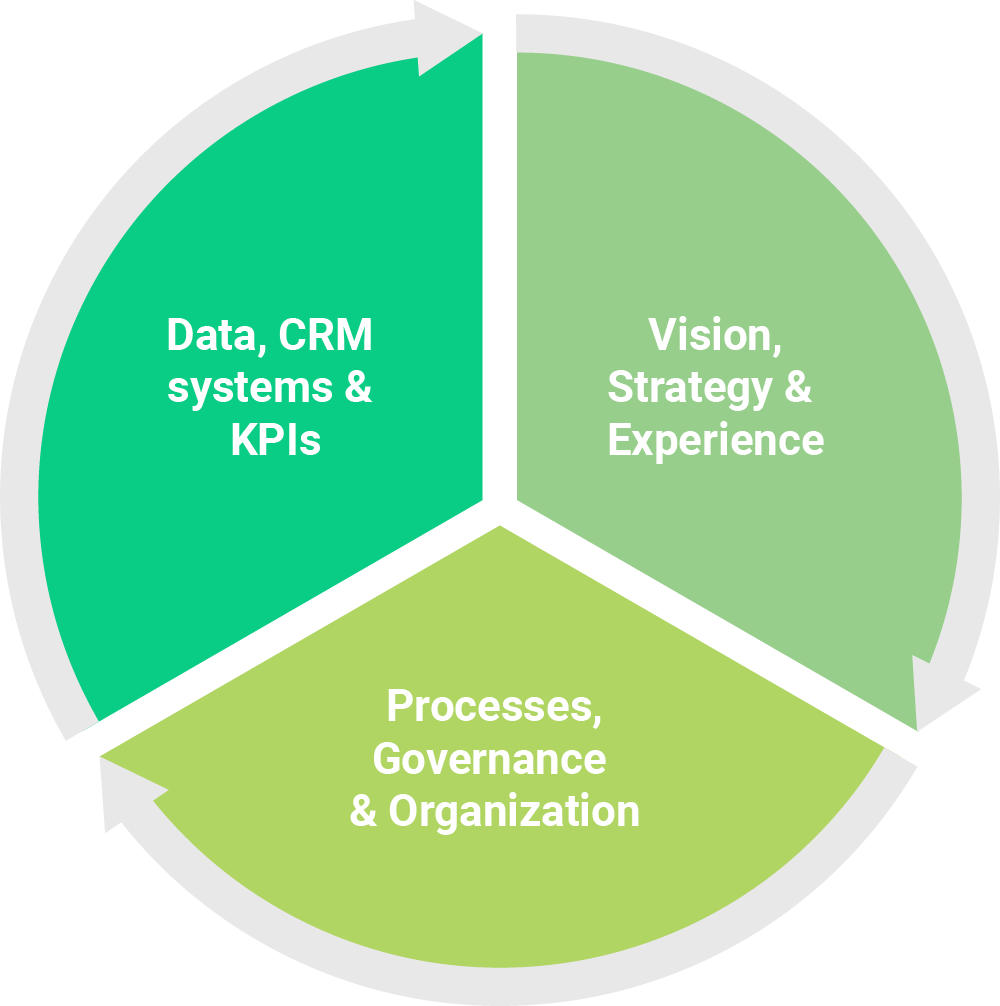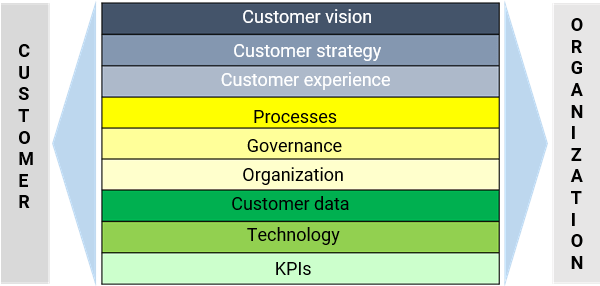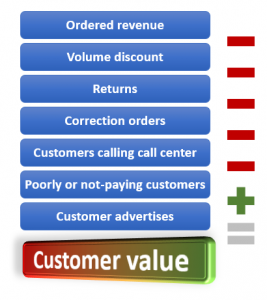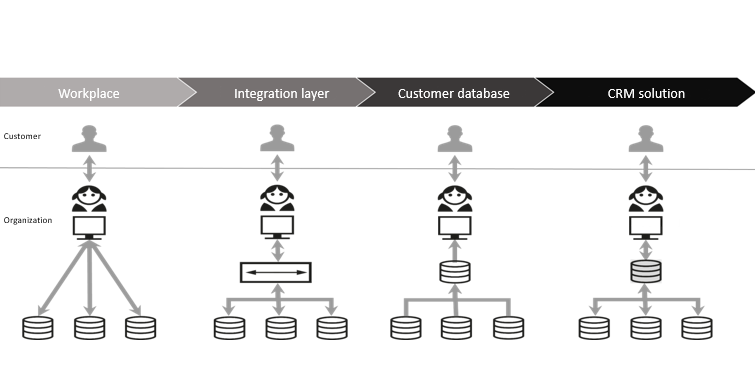CRM is an integral business strategy
A savvy business strategy is essential to a successful CRM implementation. Others essential success factors are:
- customer-focused employees;
- customer-focused processes;
- the right CRM system;
- having access to the right, current customer data.
The proven concept of the intelligent organization won’t just help you successfully implement CRM, but also to stay successful, even when your customers or their demands change. This puts the customers’ interests front and center. Not just one department or employee is responsible for customers, but the entire company acts predictably and consistently towards the customer. That then leads to effective customer interaction.
Creating new opportunities
The most exciting aspect (and that which offers the most opportunities) of CRM is creating a holistic customer approach, with a comprehensive customer profile as its foundation, using the right analyses and insights. The question nowadays is whether customers can still be followed and served across all channels. Is your organization equipped for that? Do employees have access to the right skills and systems? Because customer demands are changing rapidly these days, the organization has to be able to continuously improve.
Further reading on CRM Essentials
What are the results of implementing CRM?
Research has been done to investigate the results of implementing CRM. Among other factors, you can expect:
- Better insights into customer behavior and preferences.
- Higher customer satisfaction, more loyal customers, higher margins.
- Approaching customers at the right time with the right offer.
- Continuous quality improvement of customer processes and CRM.
- Less miscommunication between departments.
- Lower failure costs in customer contact and optimal customer interaction.
We have a knowledge base that you can consult in order to achieve these results. This knowledge base delves deeper into the subject of successful CRM implementation based on the 9-layer customer contact model.
The market is growing and developing rapidly
This year, revenue growth in CRM systems will amount to around 15%, according to Gartner. This strong growth is caused by the following trends:
- Digitization. Online sales channels and growth in online marketing are making people go increasingly digital.
- More focus on customer experience. Customers are becoming increasingly empowered. They’re also becoming more demanding when it comes to delivery and services.
- Technology going to the cloud and mobile. More and more CRM systems are delivered from the cloud. Mobile interfaces are also becoming more popular. See also: SalesForce.
- Integration of (social media) channels. Customers are using more and more different social media channels to communicate. Software vendors are working on integrating that functionality. Channel integration may not be a trend within CRM anymore, but a lot of work has to be done in this area by companies.
- Data-driven working is becoming essential. Intuitive decision-making used to be the norm, but nowadays, facts and data are key to good decision-making. Developments like data-driven marketing and Big Data are going to be instrumental in determining success or failure.
Rapid developments
Organizations have to adapt quickly to rapidly-changing environments. It used to be commonplace to implement CRM systems and processes over multiple years, but now it’s become essential to continuously follow the customer. That’s the only way to keep meeting the customer’s ever-increasing demands.
For this reason, Passionned Group has developed the concept of the intelligent organization. Using a clear strategy, you’ll continuously measure and follow your customer interactions. Based on that you’ll make rational (change) decisions. This in turn makes your company more agile and cost-efficient.
And, much more importantly: the organization meets the customers’ expectations. As a result, you can increase your revenue and a strategic customer advantage. Consistently absorbing, analyzing, and reacting to customer data has become the key asset of an intelligent organization.
The four pillars of CRM
- Customer focus: Your organization, employees, and processes have to be customer-focused in order to successfully implement the CRM strategy.
- Customer value: this is the reason that a customer should do business with your organization. Based on this value in the strategy, customers are divided into segments.
- Customer systems: we also call this CRM systems. These are all the kinds of systems the support the customer interaction of your organization.
- Customer profile: the whole of the data and information your organization is registering and using when interacting with (potential) customers.
These four pillars together determine the success of CRM in your organization. By continuously improving (PDCA) the organization remains capable of reaching its goals when it comes to customer-focused business.
CRM definitions
There are over 25 definitions of CRM out in the wild, but in the end, it stands for CReate Money. How can you earn more of your customers’ money? What do all the definitions have in common?
The various definitions of CRM
The term “CRM” can lead to some confusion, as many people have their own definition. Many see it as a company strategy, others as a process approach. The term is also frequently used to talk about customer software systems. There are many definitions – well over 25 – that are all true. These definitions have the following in common:
- The customer is central.
- Constantly striving for higher customer satisfaction.
- This leads to higher revenue and lower costs.
- A win-win situation between customers and the company.
- ICT resources play an essential part.
To prevent confusion, our advice is to discuss and set the goals and definitions of CRM within the company.
CRM implementation is not without risks
Implementing customer-focused business in an organization is no simple task. Too often, senior management thinks that as soon as CRM has been implemented, everyone works customer-focused. Unfortunately, reality is not so simple.
The risks that come with implementing CRM have to be carefully managed, during and after the implementation of CRM. Important risks to keep in mind:
- The end-customer of the organization is forgotten.
- The organization isn’t structured in a customer-focused way.
- Implementation has become dominated by ICT.
- It’s unclear which customers will benefit from implementation.
- The organization is too ambitious and can’t handle the change.
- The success of CRM isn’t measured.
- The choice of a CRM system isn’t flexible enough.
- The CRM system is seen as an independent system without integration.
- Ownership and the quality of customer data isn’t safeguarded.
Customer-focused business makes the difference
Being customer-focused is essential for businesses. It separates the winners from the losers. Research by Forrester has shown that customer-focused businesses perform much better than organizations that aren’t customer-focused. The customer-focused organization adds a lot more value. In doing so, they don’t just earn more praise from their customers; revenue and profit increase, too.
Customer value and customer-focus
Customer-focused business starts from the assumption that creating value for customers is the only way for businesses to create value for themselves. It’s hard to create a singular definition for customer-focused business. There are many popular definitions. The Customer Intimacy definition by Treacy and Wiersema is commonly referred to. But a term like “customer excellence” can also be used to describe the customer focus of your organization.

Customer-focused business is more than just a person or department that focuses on customers. It’s a designation for the vision, strategy, and customer experience, and translating that into a customer-focused organization, employees, and processes. This is supported by the right customer data, CRM systems, and measurable criteria (KPIs). Passionned Group’s specialists are eager to help you with independent advice. And of course we can help you become more customer-focused.
A fresh perspective on customer focus
An organization and its employees often have a very different perspective on customer focus than their customers. Research among employees shows that 70% think that their organization is customer-focused. But if you ask the same question to customers of that organization, it turns out that only 8% of customers thinks that the organization is customer-focused.
The big difference can be explained by customers experiencing organizations holistically. Employees often only see a part of their own organization. They’re looking from the inside-out, whereas customers look from the outside-in. That’s why it’s becoming more commonplace for organizations to design their customers processes from the outside-in. The growing popularity of service design thinking is a good example of this.
Customer focus and being customer-friendly
You can make your organization work in a customer-focused way, by prioritizing customer satisfaction and providing high-quality service. Being customer-friendly is a way of showing how customer-focused your organization is. But just being friendly towards customers without providing the service they need is not the definition of being customer-focused. That’s just being customer-friendly.
Only measuring customer satisfaction
This is the most common mistake made by organizations that want to be customer-focused: immediately measuring customer satisfaction. They don’t consider the changes the organization needs to make. When organizations want to become more customer-focused, they often start by measuring it. They might measure the NPS score (net promoter score), for example, or other customer-focused KPIs. Without adjusting the organization’s processes or the skills of its employees. There are many organizations and tools that can measure the degree of customer focus. This is often a science in and of itself, but this isn’t the solution when:
- You take measurements when you customer doesn’t know what to expect.
- The organization isn’t ready to be measured, and the relevance or urgency is lacking.
- Insights aren’t shared across departments.
- The measurements can’t be translated into concrete actions.
So what’s right way to go about it? By taking an outside-in approach instead of an inside-out approach.
Our approach: the 9-layer model
In order to make the organization more customer-focused, it’s essential work on all aspects of customer focus. For that reasons, we’ve developed the unique nine-layer customer model. This model doesn’t just show what an organization should work on. It also provides tools you can use to quickly improve your organization’s customer focus. The nine-layer model consists of the following components:

This is what each of the nine layers stands for:
- Customer vision is the starting point of any change. Put a dot on the horizon that represents how you want to treat customers. The organization’s directors ideally determines what the customer experience should be like, and how customers should see and experience the organization. The direction only sketches out what the organization should look like, and what the consequences of that should be.
- Customer strategy is the translation of the vision into concrete objectives per customer segment. This is then translated into a strategy with concrete plans and a roadmap. The organization can then execute it. It’s essential that everyone in the organization is familiar with the vision and the strategy.
- Customer experience is the key to more loyal customers, higher customer satisfaction, and more revenue. It provides a clear picture of what the organization wants to stand for. Sketch out the customer experience your customers can expect, and what the focus is.
- Processes describe how the organization works to provide the services that customers desire. It’s important to describe where the customer contact points are in every process, also called touch points. The focus should be outside-in when it comes to process design.
- Governance describes how the organization acts and where its responsibilities lie. It’s more concerned with horizontal, flat structures focused on feedback rather than hierarchical organization. It’s about the direction of the customer domain.
- Organization describes which members of the organization are responsible for which customer segments. Next, clarify how this can be functionally organized into tasks, roles, and responsibilities. Competencies of employees and organizational culture also fall under this domain.
- Customer data is the registration, maintenance, and distribution of customer data. So that employees all across the organization have access to a comprehensive customer profile. This information has to be complete, accurate, and timely for it to be used properly. When used well, customer data can be the key to the optimization of customer interaction, predictable delivery, and higher customer satisfaction.
- Technology concerns the purchasing, building, and maintenance of CRM software. This includes the infrastructure and sourcing of applications. Questions of integration and the ICT organization also fall under this aspect.
- KPIs measure the objectives of the organization with regards to customer contact. The goal is to arrive at measurable business values that can be used across the entire organization. That creates a feedback mechanism to make employees work more customer-focused.
The results of our approach
What are the results of implementing our approach in your organization? A customer-focused business can expect the following results, among others:
- Greater customer satisfaction and a better customer experience.
- Higher revenue and better margins.
- Better predictability and quality experience for customers and the organization.
- Decreasing operational costs by reducing rework.
- Adjust to changing customer expectations quicker.
- Quicker results thanks to an approach focused on implementing changes. This immediately impacts customers.
Organizations that work customer-focused achieve markedly better results than organizations that can’t or won’t distinguish themselves by doing so.
Maturity in customer focus
Not every organization has reached the same level of maturity when it comes to being customer-focused. Every organization has a different history, goals, market, and customers. It’s only natural that they have different priorities when it comes to customer focus. You can see this in the different uses of the aspects in the nine-layer model.
A good example of this is that many organizations that want to be customer-focused are quick to implement customer KPIs (mature), while the customer experience hasn’t been defined yet (immature).
There are five stages in our maturity model:
- Awareness.
- Development.
- Application.
- Optimization.
- Leadership.
These five stages of maturity can be applied to each aspect of the nine-layer model. Based on an extensive questionnaire about the current and desired situation, you can map your organization and gain insight into the gap.
Our advice is always to have the questionnaire filled in by multiple stakeholders so that the model can highlight any differences in insight that may occur in the organization. These differences can then be discussed to arrive at a shared plan of action. That way, the organization’s maturity can be improved in a controlled manner, step-by-step. If you want to know where your organization is at as a customer-focused business, take the test. You’ll immediately know your place.
If you want to get started with the outcome of this test, take a look at our offerings in Passionned Academy, or get in touch with us for a conversation. Together, we can find a solution to whatever issue your organization is facing.
Why customer-focused business is challenging
If being a customer-focused organization is more profitable in every way, then why aren’t all organizations getting in on it? The answer is that it’s not as easy as it sounds. There are seven primary reasons for this:
- Lack of vision for customer-focused working.
- Lack of inspiring leadership.
- The organizational structure is overly functional instead of customer-focused.
- Implementing a new CRM system is seen as the solution.
- Changes are often too internally focused, and there are too many at once.
- Employees aren’t invested in customer-focused working, for many reasons.
- The organization lacks passion for the customer.
If you want to improve your organization’s customer focus and better serve your customers, here are three solutions you can get started with right now:
Answer 1: Make your organization intelligent
In the book Data Science for Decision-Makers, author and founder of Passionned Group Daan van Beek explains how organizations can capitalize on changes in customer-focused business better and faster, using data. By coupling a strong vision to smart insights (analytics) and acting on it quickly and adequately, you can create the foundation for a customer-focused organization. The book, the approach described above, and our toolbox give you practical handholds to realize your organization’s customer goals.
This change approach isn’t a one-time thing. Customers keep changing, so the organization has to change with them. Implementing a continuous change process is essential in order to remain successful.
Answer 2: Constantly course-correcting your business model
Business models of existing organizations are under increasing pressure. Consider retail models that have to continuously compete with online stores. The customer is becoming less loyal and keeps expecting higher quality service. The only way to be ready for that as an organization is to be customer-focused and to constantly innovate your business model.
The intelligent organization contains all the ingredients needed to implement and improve these business models in organizations. This makes the organization much leaner and more agile.
Answer 3: Service design thinking
Customers are becoming more demanding. Distinguishing yourself through products alone isn’t enough anymore. The ability to distinguish yourself as a customer-focused business more often lies in the service domain. Service design thinking is a trend that’s increasingly commonly applied in organizations. The goal is to create the ultimate customer experience. A good example of a customer-focused business is Apple.
This video explains the essence of service design thinking in 90 seconds. If you want to know more about this approach, feel free to contact us. We’re love to talk you through what service design thinking can mean to your organization.
Successfully improve your customer focus
We have over 25 years of experience in realizing and improving customer-focused business in various industries. Using countless solutions and our own unique approach, we can help your organization become more intelligent and customer-focused. So that you can get greater returns on your investments.
Permanently increase your customer value
As a director, customer manager, or consultant, you’re always trying to find new ways to permanently increase your customer value. You’re also aware that unhappy customers negatively impact your customer value, and thus your organization as a whole. But how:
- Can you make customer thinking in your organization commonplace?
- Do you simultaneously invest in customer retention while increasing profitability?
- How do you measure customer value so that you can course-correct?
- Which data sets and KPIs can provide all-round, 360 degree insight?
- Which instruments can you use to increase customer value?
If you have one or more of these questions, meet Passionned Group’s customer value specialists.
5% more customer retention massively increases profits
In the mid 90s, Frederick Reichheld coined the term “customer lifetime value”, or CLV for short. In his book “The Loyalty Effect” he showed that, if you can increase customer retention by 5%, you can increase your profitability by 25% to 90%. The conclusion is that customer retention (and thus CRM) is lucrative over the long term.
Since then, the amount of definitions for calculating customer value has greatly increased. The most common definition is:
The net contribution of a customer based on the expected stream of assignments.
In other words: what are the customer’s net contributions to your profits as long as they remain a customer? Thus, for customer value, you look at what a customer will contribute to your organization in the future. This amount is often displayed as a net constant value.
How do you calculate customer value, or CLV?
There are many (scientific) articles about calculating customer value that often use very complex formulas. There are multiple possible answers to the question of how to calculate it. The simplest and most common formula is: CLV = W (average profit per order) x A (average amount of orders per customer).
 The average profit per order and the amount of orders are often relatively simple to extract from the order system. Using statistics systems, it’s possible to make predictions about the amount of times a customer will place orders in their lifetime. Of course, we can make things more complicated.
The average profit per order and the amount of orders are often relatively simple to extract from the order system. Using statistics systems, it’s possible to make predictions about the amount of times a customer will place orders in their lifetime. Of course, we can make things more complicated.
There are also formulas that calculate inflation, the desired period of time, and the time when a customer is predicted to leave your company. Dividing customers into segments can also provide new insights. A thorough look at the customer journey can also shed new light on the customer value.
It’s important to have a singular definition of what’s considered profit. In other words: which costs per customer do you calculate to determine their profit contribution. The quickest way to arrive at a reliable and accepted definition is to use the definition that the finance department uses.
BI helps calculate customer value
Business Intelligence is the ideal field that can help you obtain all the right information and insights from data. This is vital management information that you can use to course-correct. It’s essential for customer data to be correct, timely, and reliable. Creating a comprehensive customer profile enables you to technically and adequately answer the customer needs.
Predictive analytics
Most BI systems can use predictive models to simply extract the information from the available data. There are clear difference in functionality between various solutions. If you want to know more about these differences and which solutions are the best fit for you, Passionned Group has released a BI & Analytics Guide that investigates the major BI tools on the market.
The model of the intelligent organization
The insights and reports that you generate have to be translated into actions to really be effective. Following the steps of an intelligent organization, your organization can translate insights into action, such as registering, analyzing, and acting towards customers. This isn’t a one-time action, but a process of continuous improvement.
How can you increase your customer value?
Calculating customer value isn’t a goal in and of itself. The question is: how can you increase your customer value? This can differ per market, product, or service offered. In general there are five ways to go about this:
- Attract more customers with the right profile. Because an organization knows what the most profitable customers are (who have the highest customer value), they can focus their marketing efforts on this profile.
- Part ways with unprofitable customers. The organization can decide to leave behind customers who don’t add value. Other options are reducing costs, or charging higher prices.
- Let your customers be customers longer and increase your retention. By gaining insight into customer retention and its relevant parameters, you can bind customers to your organization longer. Well-known examples of this are loyalty programs.
- Maximize revenue per customer. You can do this by selling more of the same to existing customers (deep selling) or selling a more expensive variant of the product or service (upselling). Or you can sell more diverse products (groups) to the same customer (cross-selling).
- Optimize your existing portfolio. Terminate ageing services that are no longer viable, and motivate customers to purchase more viable alternatives.
Changes in thinking on customer value
The thinking around customer value is always developing. Customers are becoming more and more empowered. This is partly due to rapid technological developments. Determining customer value alone is no longer enough.
Many organizations are now driving customer satisfaction. To do this, they use the Net Promoter Score (NPS). That indicates to what extent customers would recommend a company to others. The assumption is that customers that answer the question “would you recommend this company to others?” with a 9 or a 10 are your ambassadors. These ambassadors end up generating more revenue.
NPS: measuring word-of-mouth
These days we increasingly see that customers don’t just buy and promote products, but also genuinely participate. Participation is about concepts like co-creation and crowdfunding, and also so-called customer communities. This participation can be expressed in the KPI: Customer Participation Value (CPV index). The problem is that there is insufficient research to use this KPI to make accurate predictions or value determinations. More research is required.
Research by Gartner shows that, when using customer communities, operating costs can be reduced by up to 50%. So there’s clearly a lot of potential within the participation domain.
Customer value remains important. But it’s no longer solely about how much a customer pays directly. They could also end up promoting your product, generating more customers and revenue. When you actively involve customers through co-creation, you end up creating products that better fit the customer’s needs. And you can then create them at considerably lower costs.
If you want to know more about what’s involved when defining, developing, and using KPIs within your organization, read more.
Why driving customer value is not easy
Determining customer value is relatively easy. As long as you have access to the right data, the right (BI) tools, and the reports have been generated, the analyses will follow. Gaining insights and translating them into improvements is the real challenge, for the following reasons:
- The market is used to the proposition. Existing customers are more profitable than new customers. Nevertheless, research shows that 90% of the marketing budget is dedicated to recruiting new customers.
- Organizations aren’t customer-focused. The organizational structure and processes are often designed function- or product-oriented. Employees think and act in alignment. Sometimes there are big dividers between the various departments. As a result, customers are served by separate departments instead of one holistic approach.
- Returns aren’t the same thing as revenue. Companies often have multiple goals. Aside from returns goals, there are usually revenue goals as well. For example, 3% of revenue growth year-over-year. That’s the reason to part ways with the groups of customers that aren’t viable. Such an action provides greater returns, but you may fall short of your revenue goals.
- There is often a lack of clear vision and daring among the direction. There’s no customer profile or is so abstract that it can be interpreted in all sorts of ways. This causes departments and employees to use their own interpretations of customer groups and products and services. This leads to a “overgrowth” of customers. It’s better to make explicit choices about which customers you do or don’t want to have.
- Reports containing customer values are not shared within the organization, for various reasons. The problem is that you then can’t do anything with the outcome of those reports.
Comprehensive customer profile: you have to work for it
Customer data is often hidden in your systems, to say nothing about the information your customers leave on the internet.
A comprehensive customer profile is often seen as the dream of every organization. If we have a comprehensive customer profile, we’ve reached our goal, and the revenue will follow. Unfortunately, reality proves to be a bit trickier. Obtaining a comprehensive customer profile comes in fits and starts.
- How do you link various internal and external sources of customer data?
- How do you maintain them and ensure the right investments?
- More importantly: how does this lead to higher revenue?
In other words, more insight doesn’t necessarily lead to more action, and thus more revenue. Feel free to let Passionned Group’s CRM specialists advise you.
Important drivers for CRM systems
The comprehensive customer profile was, for years, the driver of many (ICT) investments in CRM systems. A lot of time and energy went into this, but the results were often meager. But a comprehensive customer profile is the basis for all CRM solutions, and should be the basis for every organization that wants to be customer-focused. There are various aspects to consider when it comes to investing in a comprehensive customer profile .
Data quality: an essential aspect
Data quality is an essential part of successfully implementing a comprehensive customer profile. Data has to be used and combined correctly in order to gain a comprehensive profile of the customer. It’s a common problem: a customer who appears in the system multiple times, because their name has been spelled just a little bit differently in the various systems. Correctly linking various customer systems is very important.
New (BI) technology
In the past, connecting various systems was a big challenge. New (BI) technology has made it much easier to link various sources and systems. It’s important for these sources to have a certain level of customer recording. In the past, a lot of systems were developed that couldn’t even store email addresses, for example.
Cashing in the “asset of customer information”
A comprehensive customer profile only works if it’s actually being used. An organization has to be customer-focused if they want to cash in on the asset that is customer information. This aspect is sometimes forgotten, and is one of the risks when implementing CRM.
Trying to achieve a comprehensive customer profile in one large project that takes years has proven unsuccessful. It’s much more effective as a dot on the horizon. Improving the organization in an iterative fashion is much more likely to be successful.
How to achieve a comprehensive customer profile?
There are various ways to reach this goal. One type is more valuable than the next. The four most important types are:

- A technical screen solution (screen scraping) that shows all the information about the customer (from various systems) on one integrated screen in the workplace. Behind the scenes, it’s technically jumping between the various systems. These systems are often capable of updating various systems simultaneously. Because of this, the employee doesn’t have to continuously enter the data in various systems.
- Unlocking systems via an integration layer is the second form of building up and maintaining a comprehensive customer profile. This integration layer, also called the Enterprise Service Bus, is often combined with a form of workflow management. These two can ensure that data from various sources can be unlocked and mutated. For employees, specific applications are developed to present and mutate this data. The same integration can also be used to directly unlock customer information on the internet.
- A data warehouse stores customer information built up from various sources. For this solution, a database is created regularly (daily, weekly, or monthly) containing all the relevant customer information. This can then be used by employees. This information is read-only and not mutated. The last part happens in the various source systems. This type of solution is primarily used to support the marketing process. This is also called analytical CRM.
- The last, and by far most integrated solution, is that in which the customer information has been stored in a central CRM system/database and is mutated directly. This is also called operational CRM. In this situation, the CRM system is the central point for storage of customer information, and customer information is updated in the various software systems. This is the most commonly-used architecture solution for organizations that really want to be customer-focused.
Choosing the right architecture, one that matches the needs of the organization now and in the future, is essential to make investments future-proof. Too often, choices aren’t based on a pre-determined architecture, and investments turn out to be a dead end, and they have to start all over. Our advice is to take an enterprise architecture approach to comprehensive customer profiles.
Channel management complicates things
Customers communicate across many different channels. Things used to be simple – a customer came into the store for questions and purchases. Nowadays, customers can visit stores, use the phone, start an app, send an email, go to the website, or communicate using all kinds of social media. Customers regularly hop between various channels.
There are different ways that organizations can organize channel management. This is displayed in the image below.

- In single-channel, the customer is served from one channel.
- In multi-channel, the customer can choose multiple channels, but for the organization it’s a different customer every time.
- Cross-channel connects all the channels, but the customer still experiences them as separate channels to the organization. Contact information is shared across channels, allowing for better customer service.
- Omni-channel eliminates the differences between channels for the customer, and the organization communicates across all channels in a singular way.
Ideally, every organization would be an omni-channel organization, but that can only be achieved at a high level of investment. The organization has to grow towards this goal. Many organizations want everything, all at once, and have a different ICT solution for every channel. This makes integration of all channels very difficult.
To avoid having to make large investments in channel management that generate relatively low returns, our advice is to think very consciously about whether or not a channel has to be integrated.
One last remark about channel management: organizations try to distinguish themselves by offering more channels, or offer more service within the channel, without asking themselves whether it would lead to more revenue. Service is often seen as being free by customers. There’s an arms race ongoing to offer more channels and more service per channel, without it leading to more revenue.
For that reason, organizations should carefully consider which investments they do or don’t want to make in striving for comprehensive customer profiles. Do you really want to unlock all channels for that one profile?
Do you want to discuss this dilemma, or learn how to mount a business case for unlocking channels for a comprehensive customer profile? Drop us a line.
4 pitfalls of comprehensive customer profiles
- Thinking you can’t have a comprehensive customer profile if everything isn’t linked.
- Trying to achieve a comprehensive customer profile in one project.
- Not paying attention to data quality and data governance.
- Seeing a comprehensive customer profile as the end of the line, when it’s only the start for organizations: it has to be cashed in.
A comprehensive customer profile is never finished
The implementation of a comprehensive customer profile is often seen as a one-time activity. Unfortunately, thanks to the many developments in the field of customer interaction, the enormous growth in customer channels, and the necessity of focusing on data quality, the process of continuous improvement is a necessity. It’s the only way to keep the comprehensive customer profile up-to-date.
One-time change has become continuous change. An approach like PDCA is the ideal way for organizations to stay current, make considered investments, and innovate at the same time.
If you want your customer profile to stay up-do-date, change is the only true constant.
Do you want a comprehensive customer profile for your company?
We have over 15 years of experience in implementing CRM solutions. Using various solutions and our own unique approach, we can help you implement a comprehensive customer profile quicker, better, and more efficiently.
Successful customer-focused business
We have over 25 years of experience in implementing and improving CRM in various sectors. Using a myriad of solutions, we can help you make your organization more customer-focused and intelligent. So that you can get better returns from your organization, customers, and employees.
Do you want to discuss these topics with our one of our experts? Feel free to contact us, we’d love to hear from you.
About Passionned Group
 Passionned Group is a leading firm in designing and implementing CRM & customer-focused organizations. Our driven advisors and CRM managers assist both large and small companies towards a smarter enterprise.
Passionned Group is a leading firm in designing and implementing CRM & customer-focused organizations. Our driven advisors and CRM managers assist both large and small companies towards a smarter enterprise. 




























